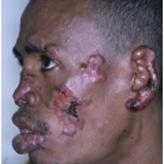 Andy Crump/TDR/WHO/Science Photo Library
Andy Crump/TDR/WHO/Science Photo Library
The leishmaniases are a group of diseases caused by infection with protozoan parasites of the genus Leishmania. They affect the poorest of the poor and are associated with malnutrition, wars, displacement, poor housing, illiteracy, gender discrimination, lack of resources, and environmental changes. The infection is transmitted by bites from sandflies infected with the parasite. The World Health Organization (WHO) considers leishmaniasis to be one of the most serious parasitic diseases, and the World Health Assembly has advocated that authorities should address the major factors underlying the failure to control the disease.
There are two main clinical presentation forms (cutaneous and visceral), associated with a broad range of symptoms and degrees of severity. Cutaneous leishmaniasis is a disfiguring and stigmatising skin infection that causes inflammation, ulcers, and scars, with great suffering for the affected patients and their families. It is a growing social and health problem worldwide, but it gets less attention than the visceral form because it is not directly fatal. There are about 1.5 million new cases of cutaneous leishmaniasis per year and 12 million people currently have some form of leishmaniasis. The disease appears to be underestimated and on the rise in several countries, mainly in South America and the Middle East. The stigma and the economic effects on households produce an important impact on the estimates of disability‐adjusted life years that increases the impact of the accounted burden of disease.
Routine control of cutaneous leishmaniasis depends on early detection, prompt treatment, and, when feasible, vector and reservoir control. The value of the various treatment and prevention measures needs to be well established as there is growing demand for new treatment and prevention strategies. Many topical and systemic treatments for cutaneous leishmaniasis have been described, but there is sometimes a lack of availability of most of these treatments in rural and poorer areas, where the majority of leishmaniasis occurs.
Therapeutic options have been evaluated in two Cochrane Reviews, on interventions for old‐world and American leishmaniasis. The international author teams for these reviews have been supported by the Cochrane Skin Group, the WHO's Control of Neglected Tropical Diseases division, the Spanish Agency for International Cooperation and Development (AECI), and the International Health Central American Institute (IHCAI) Foundation. The reviews' findings have informed the WHO strategy for the control of cutaneous leishmaniasis, with the main objective of ensuring that there is readily accessible, good‐quality information on the impact of interventions. The review on American leishmaniasis was awarded the Health Agenda for the Americas 2008–2017 Prize by the Pan American Health Organization (PAHO) and the Iberoamerican Cochrane Centre, recognising the work's high quality and utility for treating a neglected disease in many countries. The review authors also pointed out the need for better designed and reported clinical trials on cutaneous leishmaniasis, leading to the development of a new model for describing implications for research in Cochrane Reviews.
One challenge for global health is to enable all people and institutions interested in the control of neglected diseases to gain access to the evidence in an appropriate and timely form. Promoting evidence‐based health and clinical research on neglected diseases could help millions of people improve their quality of life in a more just and sustainable world. Cochrane Reviews on cutaneous leishmaniasis are an example of commitment to achieve real and significant worldwide impact on guiding and promoting health care, policy decisions, and priorities for future clinical research. There is also a need to increase the visibility of this neglected disease, coming from well‐informed communities at international, national, and local levels contributing to best health care.
Feedback on this editorial and proposals for future editorials are welcome.
End Notes
Declarations of interest
The author has completed the Unified Competing Interest form at icmje.org/coi_disclosure.pdf (available upon request) and declares (1) no receipt of payment or support in kind for any aspect of the article; (2) no financial relationships with any entities that have an interest related to the submitted work; and (3) no other relationships or activities that could be perceived as having influenced, or giving the appearance of potentially influencing, what was written in the submitted work.
References
- World Health Organization. Leishmaniasis: burden of disease. www.who.int/leishmaniasis/burden/en (accessed 10 March 2013).
- World Health Organization. Control of leishmaniasis: report by the secretariat. March 2007. apps.who.int/gb/ebwha/pdf_files/WHA60/A60_10‐en.pdf (accessed 10 March 2013).
- World Health Organization. Leishmaniasis: magnitude of the problem. www.who.int/leishmaniasis/burden/magnitude/burden_magnitude/en/ (accessed 26 March 2013).
- González U, Pinart M, Reveiz L, Alvar J. Interventions for Old World cutaneous leishmaniasis. Cochrane Database of Systematic Reviews 2008;4:CD005067. doi.org/10.1002/14651858.CD005067.pub3 [DOI] [PubMed] [Google Scholar]
- González U, Pinart M, Rengifo‐Pardo M, Macaya A, Alvar J, Tweed JA. Interventions for American cutaneous and mucocutaneous leishmaniasis. Cochrane Database of Systematic Reviews 2009;2:CD004834. doi.org/10.1002/14651858.CD004834.pub2 [DOI] [PubMed] [Google Scholar]
- Control of the leishmaniasis: report of a meeting of the WHO Expert Committee on the Control of Leishmaniases, Geneva, 22–26 March 2010. WHO Technical Report No. 949. apps.who.int/iris/bitstream/10665/44412/1/WHO_TRS_949_eng.pdf (accessed 10 March 2013)
- Pan American Health Organization. Health Agenda for the Americas 2008–2017 Prize. new.paho.org/hq/index.php?option=com_content&view=article&id=4402 (accessed 10 March 2013)
- González U, Pinart M, Reveiz L, Rengifo‐Pardo M, Tweed J, Macaya A, et al. Designing and reporting clinical trials on treatments for cutaneous leishmaniasis. Clinical Infectious Diseases 2010;51:409–419. doi.org/10.1086/655134 [DOI] [PubMed] [Google Scholar]
- González U; Williams H. Implications for research: getting the most out of Cochrane Reviews [editorial]. Cochrane Database of Systematic Reviews 2011. Dec 7; 1:ED000037.doi.org/10.1002/14651858.ED000037 [DOI] [PMC free article] [PubMed] [Google Scholar]


